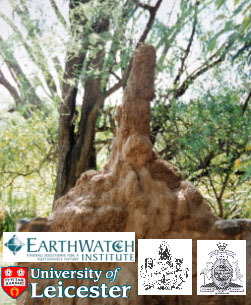| The
Darwin Initiative at Lake Bogoria:
The
Darwin Bogoria-Flamingo Project is
akin to a termite colony, whose mounds
form major structures in this beautiful,
arid landscape. Both are structured
and integrated at all levels. We network
with the local communities; producing
and sharing scientific understanding
to help underpin their move tosustainable
livelihoods.
Click
on the links below for further details
Scientific
research |

|
Local
communities |
Capacity-building
|
Educational
work |
| |
| Scientific
research has met four objectives |
|
|
|
|
 |
|
|
|
|
| 1.
Seven adult male lesser flamingos satellite
tracked, yielding new data about their use
of lakes and frequency of movements |
 |
|
|
|
|
| 2.
The three key Kenyan flamingo lakes - Bogoria,
Elmenteita and Nakuru - intensively monitored
over three years to provide new insights
into their limnological stability and flamingo
use of them. |
 |
|
|
|
|
| 3.
Causes of past flamingo mass-mortality events
investigated through post-mortems; flamingo
health through morphometric analysis and
blood sampling. Preliminary conclusions are
that mortalities are not caused by direct
pollution, as had been feared. |
 |
|
|
|
|
| 4.
The biodiversity of Lake Bogoria National
Reserve quantified for dragonflies & damselflies,
moths, birds, beetles, flowering plants and
grasses |
Back
to Darwin Initiative Introduction
|
| The
local communities have been assisted in
four ways |
| |
|
|
|
|
| 1.
Three short films in Swahili made with local
farmers, for them, about sustainable farming |
|
|
|
|
| 2. Local people trained in ecotourism
skills |
|
|
|
|
| 3. Langstroth bee hives made and the benefits
of their use disseminated. |
|
|
|
|
| 4. One new laboratory brought to Koibatek
with enough equipment to rehabilitate existing
labs at three other Rift Valley lakes. |
|
|
|
|
Back
to Darwin Initiative Introduction
Capacity-building
has been at four levels amongst project
partners |
| 1. Two postgraduates trained (1 Darwin Fellow,
other M.Sc.) |
|
|
|
|
| 2.
Eight undergraduates trained (2 f-t in Nairobi & Mweka;
6 Leicester D-L) |
|
|
|
|
3. Over twenty attended intensive 2-week
training as part of Earthwatch field
research
camps at two soda lakes |
|
|
4. Over 100 young professionals from 3 East
African countries
trained on 1-week field workshops in conservation
issues -
“
Ecosystem Health” “Taxonomy for
Biodiversity Conservation”
and “Ramsar Management Plans”. |
|
|
Back
to Darwin Initiative Introduction
|
|
|
|
|
Educational
work has reached over 2000 local children
in nursery
(2), primary
(9) and secondary (2) schools
|
1.
All schools adopted an animal Logo, incorporated
into headed notepaper. Wall maps also given
to all, to promote
local identity. |
|
|
|
|
2.
Secondary schools were given microscopes
and computers. Top pupils visited each research
camp.
Earthwatch Teacher Fellows took classes. |
|
|
|
|
| 3.
Primary schools were given wall posters and
work books. |
|
|
|
|
| 4.
Story books were written and produced to
bring flamingo biology and conservation into
pupils
lives |
|
|
|
|
| 5. Films made with them, for them, singing
songs and reciting poems about conservation
and water |
|
|
|
|
Back
to Darwin Initiative Introduction |